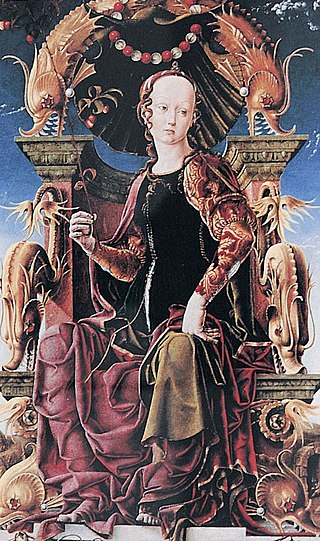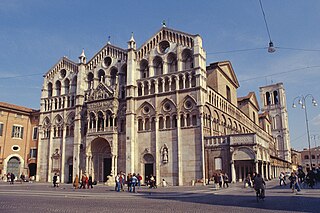
Ferrara is a city and comune (municipality) in Emilia-Romagna, Northern Italy, capital of the province of Ferrara. As of 2016, it had 132,009 inhabitants. It is situated 44 kilometres northeast of Bologna, on the Po di Volano, a branch channel of the main stream of the Po River, located 5 km north. The town has broad streets and numerous palaces dating from the Renaissance, when it hosted the court of the House of Este. For its beauty and cultural importance, it has been designated by UNESCO as a World Heritage Site.

Jacopo della Quercia, also known as Jacopo di Pietro d'Agnolo di Guarnieri, was an Italian sculptor of the Renaissance, a contemporary of Brunelleschi, Ghiberti and Donatello. He is considered a precursor of Michelangelo.

Cosmè Tura, also known as Il Cosmè or Cosimo Tura, was an Italian early-Renaissance painter and considered one of the founders of the School of Ferrara. He provided a great contribution to the Renaissance in Ferrara.

Palazzo Schifanoia is a Renaissance palace in Ferrara, Emilia-Romagna (Italy) built for the Este family. The name "Schifanoia" is thought to originate from "schifare la noia" meaning literally to "escape from boredom" which describes accurately the original intention of the palazzo and the other villas in close proximity where the Este court relaxed. The highlights of its decorations are the allegorical frescoes with details in tempera by or after Francesco del Cossa and Cosmè Tura, executed ca 1469–70, a unique survival of their time.

Palazzo dei Diamanti is a Renaissance palace located on Corso Ercole I d'Este 21 in Ferrara, region of Emilia Romagna, Italy. The main floor of the Palace houses the Pinacoteca Nazionale di Ferrara.

Ercole de' Roberti, also known as Ercole Ferrarese or Ercole da Ferrara, was an Italian artist of the Early Renaissance and the School of Ferrara. He was profiled in Vasari's Le Vite delle più eccellenti pittori, scultori, ed architettori. The son of the doorkeeper at the Este castle, Ercole later held the position of court artist for the Este family in Ferrara. According to Vasari:
Ercole had an extraordinary love of wine, and his frequent drunkenness did much to shorten his life, which he had enjoyed without any accident up to the age of forty, when he was smitten one day by apoplexy, which made an end of him in a short time.
The decade of the 1460s in art involved some significant events.

Ferrara Cathedral is a Roman Catholic cathedral and minor basilica in Ferrara, Northern Italy. Dedicated to Saint George, the patron saint of the city, it is the seat of the Archbishop of Ferrara and the largest religious building in the city.

The Galleria Estense is an art gallery in the heart of Modena, centred around the collection of the d’Este family: rulers of Modena, Reggio and Ferrara from 1289 to 1796. Located on the top floor of the Palazzo dei Musei, on the St. Augustine square, the museum showcases a vast array of works ranging from fresco and oil painting to marble, polychrome and terracotta sculpture; musical instruments; numismatics; curios and decorative antiques.

Taddeo Crivelli, also known as Taddeo da Ferrara, was an Italian painter of illuminated manuscripts. He is considered one of the foremost 15th-century illuminators of the Ferrara school, and also has the distinction of being the probable engraver of the first book illustrated with maps, which was also the first book using engraving.

Baldassare Estense was an Italian painter.

Angelo Maccagnino, also known as Angelo da Siena, was an Italian Renaissance painter.
The Studiolo of the Palazzo Belfiore was a former study, or room for intellectual pursuits, that was once found in a razed Renaissance palace in Ferrara, region of Emilia-Romagna, Italy. While the palace has disappeared, records do list the paintings, consisting of depictions of muses, that hung in the room. These secular works are now dispersed across museums, but their collective presences recall the renewed attention of Renaissance patrons to symbols from classic mythology.

The Pinacotecta Nazionale is an art gallery in Ferrara, Emilia-Romagna, Italy. It is located on the piano nobile of the Palazzo dei Diamanti, a work of Renaissance architecture by Biagio Rossetti, commissioned by Leonello d’Este in 1447. Not to be confused with the Civic Museum on the lower floor, which has hosted temporary exhibitions of contemporary art since 1992, the Pinacoteca houses a collection of paintings by the Ferrarese School dating from the thirteenth to the eighteenth centuries. It was founded in 1836 by the Municipality of Ferrara after Napoleon's widespread dissolution of churches threatened the protection of important public artworks. The gallery is formed as much around notable northern Italian painters as it is around the exquisite interior decoration of the palace itself, together with remnants of frescoes from local churches and later acquisitions from the Sacrati Strozzi collection.

Saint Jerome is a painting in oil and tempera on panel by Cosmè Tura, probably of around 1470, which has been in the National Gallery in London since 1867.

Saint Anthony of Padua is an oil on panel painting by Cosmè Tura, executed c. 1484–1490, one of the artist's last works. It is held in the Galleria Estense in Modena.

Saint Dominic is a painting in tempera and gold on panel of c. 1475 by Cosmè Tura, now in the Uffizi in Florence.

The Roverella Altarpiece was a religious painting by Cosmè Tura completed during 1470–1474 using oil and egg-tempera on poplar panel work, commissioned by abbot and cardinal Bartolomeo Roverella for San Giorgio fuori le mura in Ferrara in memory of his brother bishop Lorenzo Roverella. It was one of the most significant works of the artist and of the Ferrara Renaissance in general. It was damaged in an explosion in 1709 and moved out of the church. It is now dismembered and their panels split up between several museums.

The Saint Maurelius Altarpiece was an oil on panel painting by Cosmè Tura, executed c. 1480, produced for the church of San Giorgio fuori le mura, site of Maurelius of Voghenza's shrine. Two tondos from it survive, Trial of St Maurelius and Martyrdom of St Maurelius, both now in the city's Pinacoteca Nazionale.

The Renaissance in Ferrara began with the signoria of Leonello d'Este around the mid-15th century. Under Leonello's patronage, Ferrara became a hub for the arts and intellectual thought, attracting prominent artists and scholars of the time. A significant contribution came from the school of painters, including Cosmè Tura, Francesco del Cossa, and Ercole de' Roberti. These artists were known for their innovative use of color, intricate detail, and emotive expressions, helping to define early Italian Renaissance art.



















